Travelling with your dog isn’t just a walk in the park, it’s a grand, tail-thumping that demands your attention. So we must understand “How to travel with a dog?“🐶
Imagine you and your dog side by side conquering the world together. Now, imagine chaos, confusion, and complaints. Not as dreamy right?
That’s why planning isn’t just about ticking off a checklist, it’s about securing your dog’s well-being throughout the travel.🧳
So, buckle up, or rather, leash up. Because we’re about to embark on an adventure filled with beauty and bark!
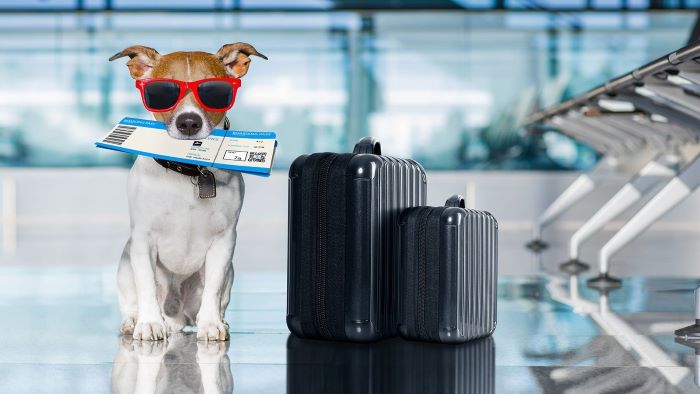
How to Travel With a Dog?
Before embarking on your adventure there are some crucial tasks you need to undertake, let’s look into them one at a time!
Schedule a visit to the vet[1]. Confirm that your dog’s vaccinations are up-to-date, protecting them from any unexpected health hiccups.
Get the necessary health certificates required for travel,🧳 ensuring you’ve got all your dog’s paperwork in line.
Think of this as your dog’s passport in the dog’s world. First, get your dog🐶 microchipped, a tiny device implanted under the skin carrying all their vital details.
Additionally, a collar decked out with an ID tag should include your contact information. This way, even if your dog decides to play hide and seek, you’ve got a reliable way to seek them out.
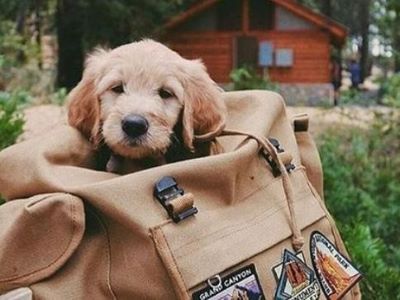
| Travel Essentials🧳 | Explanation |
|---|---|
| Crate or Carrier | Select a cosy and secure crate. Ensure it’s well-ventilated and roomy enough for a comfortable lie-down. |
| Leash and Harness🐕🦺 | Choose sturdy, comfy options for those ‘walkies’ moments. |
| Food and Water Bowls | Carry collapsible bowls. Keep your four-legged friend well-fed and hydrated on the go. |
| Dog Food and Treats🍬 | Pack ample amounts of your dog’s regular food for the trip and a little extra. Use them wisely to maintain those delightful wagging tails.🐕 |
| Comfort Items | Bring a blanket and toys. They stave off boredom and offer a familiar sense of normalcy to your dog. |
| First Aid Kit | Basic first aid kit featuring bandages, antiseptic wipes, and any specific medications your dog may need. Familiarise yourself with fundamental first aid methods because you never know when they might come in handy.💼 |
Choosing the Mode of Transportation
According to your plan, you can travel🧳 anywhere by any means of transportation but what about dogs? Let’s see some ways of transportation with dogs:
1) Car Travel
Before you hit the road, ensure your dog is properly secured. Use a sturdy harness, a dog🐶 seat belt, or a secure travel crate. This not only keeps your pup safe but also prevents any cheeky attempts to take over the driver’s seat. 🚗

Just like us, dogs need regular pit stops. Plan breaks to let your dog stretch their legs, have a sniff around, and do their business.
It’s not just about reaching your destination, it’s about enjoying the journey together.
2) Air Travel
Different airlines have different rules when it comes to flying with pets. Understand the airline’s pet policies earlier. Don’t let your dog be caught off guard by surprise rules!
Gradually introduce the travel crate at home, making it a positive and familiar space. Add blankets and toys to create a cosy atmosphere. ✈️
This way, your dog feels more at ease when it’s time to take to the skies. Organisation is key! Have all the required paperwork: health certificates, vaccination records, and identification.
3) Train Travel
Each train company has its own set of rules for travelling with pets. Explore and understand their policies, whether there are specific pet carriages, size limitations, or any additional requirements.
Knowledge is power, especially when it comes to dog’s train adventures. Your dog’s carrier is their mobile haven during train journeys. Make sure it’s well-ventilated, comfortable, and secure.
Familiarise your dog🐶 with the carrier at home, turning it into a familiar and comforting space for the journey ahead.🚆
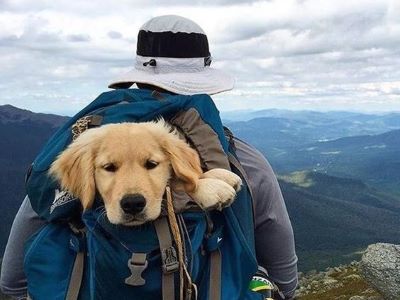
Accommodations
While booking your places for accommodations, it is a blessing to find pet-friendly places.🐶✅ Let’s explore how can you do this:
🐾Book in Advance: Finding the perfect dog-friendly place involves a bit of detective work. Use the power of the internet to search for hotels, guesthouses, or holiday homes that welcome furry guests. Check reviews and ratings to ensure[2].📌📍
🐾Hotel’s Pet Policies: Not all pet-friendly places are created equal. Some may have size restrictions, breed limitations, or specific rules. Carefully read through the hotel’s pet policies to avoid any surprises. It’s all about finding a home away from home where both you and your dog feel welcome.
🐾Settling-In Routine: Dogs, like humans, appreciate a routine. When you arrive, establish a settling-in routine. This could include a short walk around the new surroundings, introducing your dog to the room, and setting up their bed or favourite blanket.
🐾Dog-Friendly Areas: Choose the designated dog-friendly zones within the accommodation. Some places may have pet-friendly gardens, walking paths, or even special play areas. Familiarise yourself with these spots so that your dog can stretch their legs and enjoy some exploration.🐶✅
🐾Communication: Don’t be shy to let the staff know you’ve got a dog with you. They might have extra tips, services, or even a special doggy treat waiting for your dog. Clear communication ensures a smoother stay for everyone involved.
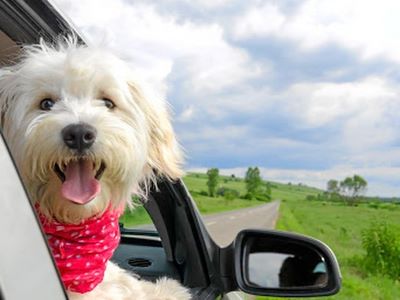
Health and Safety on the Road
Here are some tips to maintain your dog’s health and safety on the road:
- Just like us, dogs need to stretch their legs and enjoy some fresh air. Plan regular stops at dog-friendly parks or designated rest areas. These spots are not only great for a game of fetch but also offer a chance for your dog🐶 to explore new scents and sights.
- While your dog may be the friendliest around, it’s important to put on a leash in public areas.🐕🦺 Keep your dog on a lead to ensure their safety and the comfort of other travellers.🧳 It’s a simple rule that makes for a more enjoyable and stress-free experience for everyone.
- Be attentive to signs of stress or discomfort such as excessive panting, whining, or restlessness. If your dog suddenly behaves differently, it might be their way of saying, “Hey, I need a break or a little comfort.”
- Dogs, much like humans, take some time to adjust to new environments. Give your pup a chance to sniff around and get familiar with the surroundings. Introduce them to the room, the garden, or any dog-friendly areas.
Don’t forget to keep your dog🐶 well-hydrated, especially during breaks. Carry a portable water bowl and offer water regularly, especially on warmer days. Hydration is important.
Monitor your dog closely for signs they are too hot or cold. Check our tips for how to keep dogs warm while camping if overnight temperatures drop
Emergency Preparedness
Before you hit the road, do a bit of research to identify vet services along your route and at your destination. This helps in unexpected health concerns. Look for clinics with positive reviews.
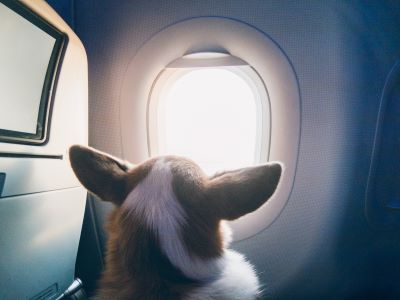
Keep the contact details of these vet services handy. It’s a good idea to save their numbers on your phone or note them down in your travel documents.
Compile a folder with your dog’s medical records, including vaccination history, recent check-ups, and any ongoing medications. Having a clear and organised record makes it easier for the vet to understand your dog’s health background, especially in an emergency.
Familiarise yourself with local animal regulations, whether it’s about leash laws, designated dog areas, or any specific requirements for travelling🧳 with a dog.🐶
Keep your dog on a lead where required, clean up after them, and be mindful of local customs regarding pets.
Consider using pet-friendly🐶✅ apps that can help you locate nearby vets, provide information on local regulations, and even suggest dog-friendly places.
When camping, use the best tents for camping with dogs to keep your dog safe and comfortable in case of unexpected weather conditions.
FAQs
❓How to Travel With a Dog?
The safest way for your pet to travel is in a carrier that has been strapped to the seat with a seatbelt or other anchor. Make sure the carrier is large enough for your dog to stand up, turn around, and lie down. You can also use a pet seatbelt, but these have not been proven to protect animals during a car crash.
❓What Is the Best Method of Travel With a Dog?
Kennels are the best way to keep your pooch safe and ensure they aren’t distracting you while you navigate and drive. However, if you’d prefer to keep an eye on your buddy during your trip, you can purchase a harness or car seat that buckles into your vehicle’s seatbelt system.
❓How Do You Travel With a Dog on a Plane?
If the weight of the pet, including the container does not exceed 5 kg, you can carry them in the cabin. Pets weighing 32 kg, including the weight of the kennel/crate, are permitted as checked-in baggage and beyond 32 kg should be booked as cargo.
❓How Stressful Is Flying for Dogs?
The simple answer though is, that flying can be quite stressful for dogs but with the correct preparation, that stress level can be greatly reduced. And let’s not forget, that different dogs handle situations differently. Some will hunker down and sleep for the duration, others might be excited, and some will be nervous.
❓Do Dog’s Ears Hurt on Planes?
How does earache occur in dogs travelling by plane? As with humans, animals can also experience barotrauma when travelling by plane. This injury is caused by an imbalance between the environmental pressure inside the aircraft and the pressure inside the middle ear cavity.
Conclusion
In conclusion “How to travel with a dog?“🧳 Like planning the ultimate fetch game, planning is the key. Whether you’re cruising, soaring, or choo-chooing, each mode has its own set of rules.
Keep your dog mentally and physically exercised to prevent boredom and excessive barking. Check our guide on, “how to stop dogs from barking when camping” for more guidance.
Secure your dog,🐶 and know the policies. Regular breaks, leash manners, and a vigilant eye on your dog’s behaviour, it’s the secret potion for a healthy, happy journey.
By following these tips, you’re not just making sure your dog stays safe; you’re curating an adventure. After all, every journey is better with a wagging tail by your side!
Reference:
- BeChewy Editors. (2023, May 22). How to Travel with your Dog: A complete guide to hitting the road with your pup. BeChewy.
- Staff, A. (2023f, November 9). The complete guide to travelling with your dog. American Kennel Club.



